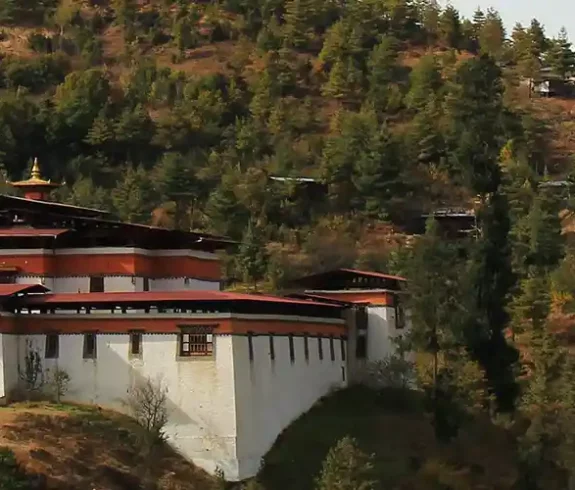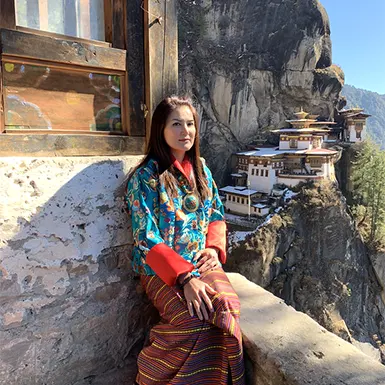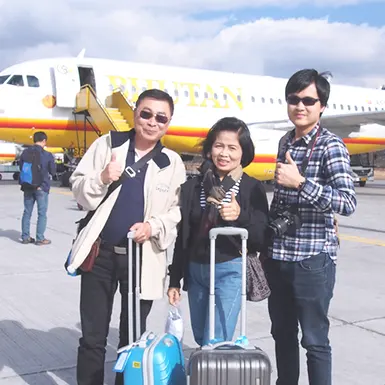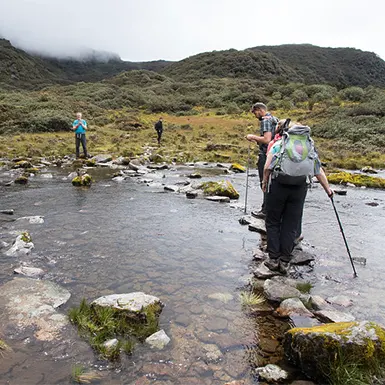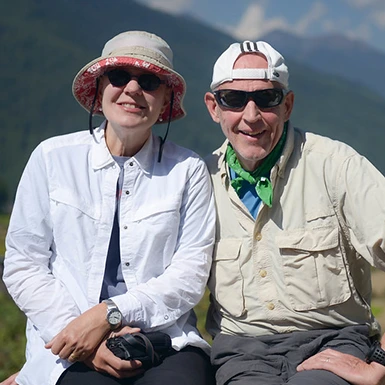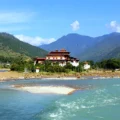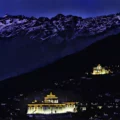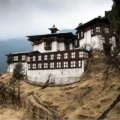Nestled among the majestic Himalayan foothills, just a short distance from Bhutan’s capital city of Thimphu, the imposing structure of Simtokha Dzong rises. More than just a structure, the Dzong (or Sangak Zabdhon Phodrang, meaning “Palace of the Profound Meaning of Secret Mantras”) embodies Bhutan’s profound history and spiritual traditions.
A Legacy Carved in Stone
Simtokha Dzong, one of Bhutan’s oldest fortresses, proudly recounts a rich history from the 17th century. Zhabdrung Ngawang Namgyal, the unifier of Bhutan, built the fortress in 1629. Perched strategically atop a hill overlooking the Thimphu Valley, Sangak Zabdhon Phodrang served as a vital stronghold, offering panoramic views for surveillance and fortifying the kingdom against potential threats.
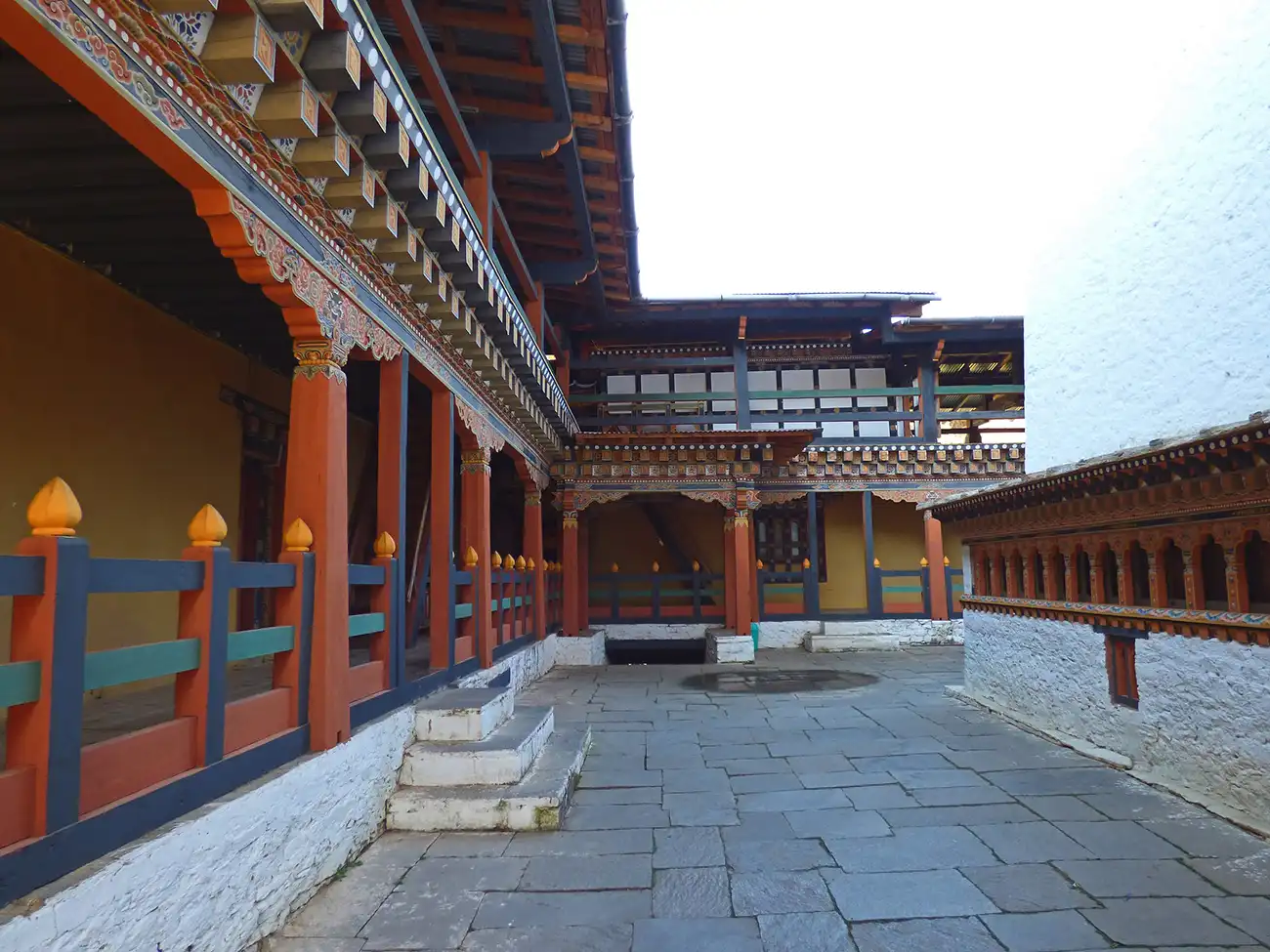
More Than Just a Fortress
The role of Sangak Zabdhon Phodrang extended beyond a military stronghold; it exemplified the innovative Bhutanese concept of a “Dzong” – a combination of a monastic center and an administrative hub. This fusion fostered a balanced coexistence between spiritual practices and governance, significantly shaping Bhutanese society.
Sangak Zabdhon Phodrang ‘s architectural splendor and role in Bhutanese lore demonstrate its historical importance. It was the site of a significant confrontation when defenders of the Dzong repelled an attack by discontented lamas allied with Tibetan forces. Their victory cemented Simtokha Dzong’s reputation as an unassailable fortress and a symbol of Bhutan’s enduring strength.
A Fortress Forged in History: Simtokha Dzong’s Past
Simtokha Dzong, a cornerstone of Bhutanese heritage, boasts a captivating history that intertwines strategic brilliance with spiritual devotion.
Visionary Leadership and Strategic Defense
In 1629, Zhabdrung Ngawang Namgyal, Bhutan’s visionary unifier, established Sangak Zabdhon Phodrang. He recognized the hilltop’s strategic advantage overlooking the Thimphu Valley and sought to fortify the newly united kingdom against potential invaders. This strategic move gave birth to the dzong system—a network of fortresses that would shape Bhutan’s landscape and governance for centuries.
A Harmonious Blend of Defense and Spirituality
Dzong transcends its role as a mere military installation. It is a dual-purpose marvel, seamlessly integrating a formidable stronghold with a vibrant spiritual center. The Dzong’s architectural layout reflects this harmonious blend, where intricate temples and monastic quarters share space with imposing defensive walls and vigilant watchtowers. This unique fusion of secular and sacred purposes remains a defining characteristic of Bhutanese dzongs.
Tales of Resilience and Triumph
Sangak Zabdhon Phodrang has faced its fair share of adversity throughout its storied past. It endured attacks from Tibetan forces and rival Buddhist factions in its early years. Yet, it emerged from these trials more vigorous than ever, solidifying its status as a symbol of Bhutanese resilience and the unyielding authority of the Zhabdrung.
A Living Legacy
Sangak Zabdhon Phodrang’s significance reaches far beyond its storied past. It remains a vibrant hub of cultural and religious activity, pulsating with life and tradition. Its weathered walls and centuries-old murals tell silent stories of battles fought, prayers offered, and traditions upheld. Each corner of the Dzong invites visitors to connect with Bhutan’s rich and enduring legacy, which continues to inspire and captivate.
A Masterclass in Bhutanese Architecture
The architectural features of Simtokha Dzong are nothing short of awe-inspiring. They encapsulate centuries of Bhutanese craftsmanship and spiritual symbolism.
A Glimpse into Bhutanese Design
- Dzong Structure: Sangak Zabdhon Phodrang embodies the classic dzong layout – a fortified complex centered around a towering Utse (central tower). The Dzong’s layout adheres to the principles of Buddhist cosmology, with the Utse representing Mount Meru, the mythical center of the universe.
- Massive Walls: The Dzong’s exterior boasts imposing stone walls whitewashed with traditional lime plaster. These walls serve a defensive purpose and contribute to the Dzong’s majestic presence.
- Intricate Woodwork: Bhutanese artisans are renowned for their woodworking skills, and Sangak Zabdhon Phodrang showcases this mastery in abundance. Elaborate carvings depict mythical creatures, floral motifs, and geometric patterns and adorn windows, doors, and balconies.
- Vibrant Colors: The Dzong’s interiors burst with color, thanks to the intricate murals and frescoes that adorn the walls. These artworks depict Buddhist deities, scenes from religious texts, and historical events, creating a visual feast for visitors.
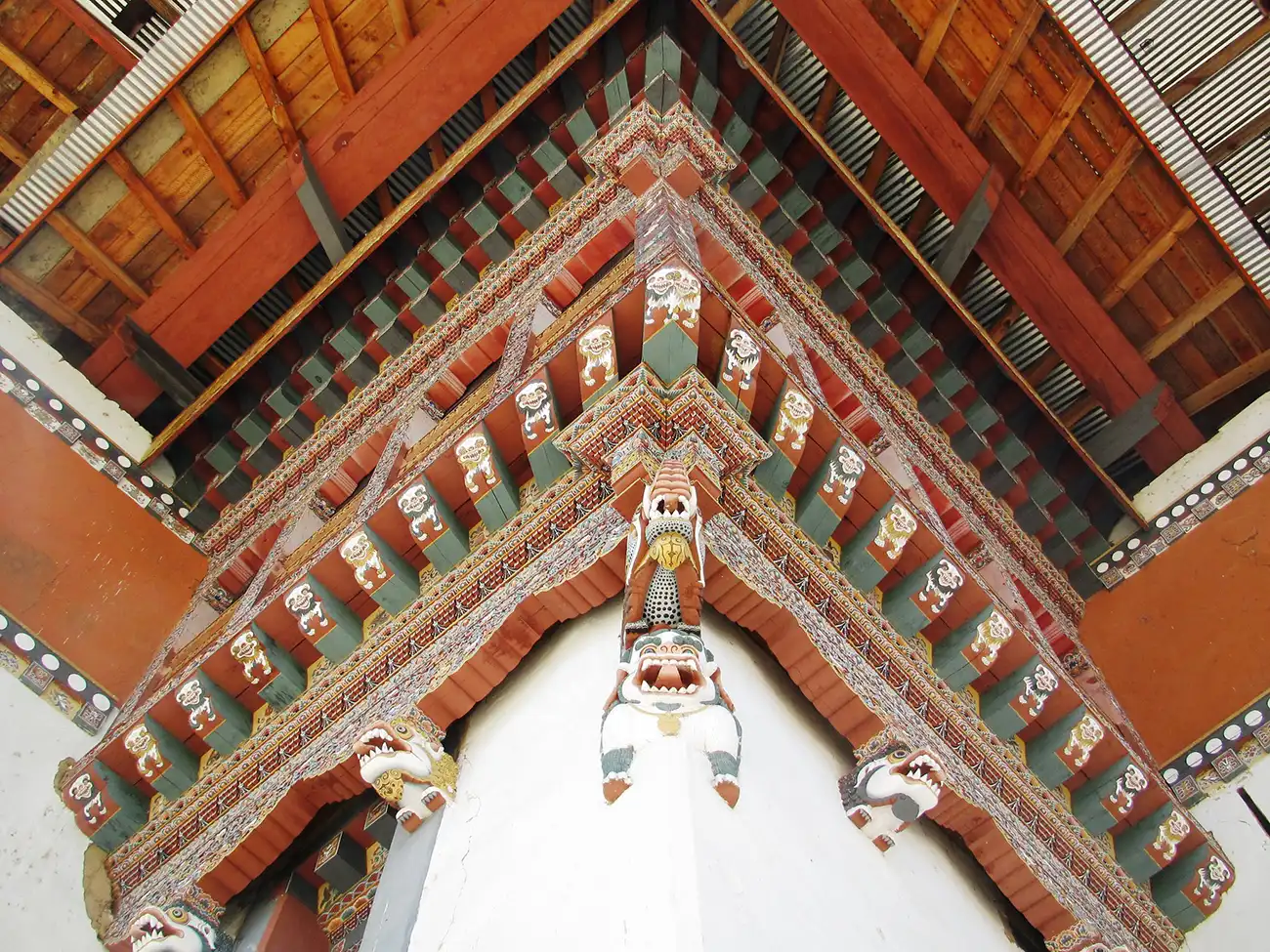
Artistic Treasures
- Mural Masterpieces: The murals within Sangak Zabdhon Phodrang are considered some of the oldest and most precious in Bhutan. They provide a glimpse into the artistic traditions of the 17th century and offer valuable insights into Bhutanese religious beliefs.
- Sacred Statues: The Dzong houses several revered statues of Buddhist deities, including Guru Rinpoche (Padmasambhava), the founder of Tibetan Buddhism, and the eight bodhisattvas.
- Antique Artifacts: It also preserves a collection of antique artifacts, including weaponry, religious objects, and historical documents, offering a tangible connection to Bhutan’s past.
Beyond the Stone Walls: Unveiling the Spiritual Heart of Simtokha Dzong
More than just a fortress, Simtokha Dzong pulsates with spiritual energy, acting as a vital center for Bhutanese Buddhism and cultural preservation.
A Beacon of Buddhist Devotion
- Monastic Community: Sangak Zabdhon Phodrang is home to a vibrant community of monks who immerse themselves in Buddhist scholarship and practice. They uphold the Dzong’s spiritual traditions and contribute to the preservation of Bhutan’s unique cultural identity.
- Institute of Language and Culture Studies: The prestigious Institute for Language and Culture Studies is within the Dzong’s walls. This institution is crucial in safeguarding the Dzongkha language and promoting Bhutanese cultural heritage.
- Spiritual Haven: Simtokha Dzong offers a tranquil haven for monks and visitors seeking solace and spiritual connection. Its peaceful courtyards, adorned with prayer flags and wheels, invite quiet contemplation and reflection.
Sacred Festivals and Celebrations
Simtokha Dzong comes alive during religious festivals known as tshechus. These vibrant events showcase Bhutanese culture through masked dances, traditional music, and colorful processions. Key festivals held at Sangak Zabdhon Phodrang include:
- Simtokha Tshechu: This annual festival honors Guru Rinpoche and features masked dances performed by monks, reenacting historical and spiritual events.
- Other Tshechus: Throughout the year, the Dzong hosts smaller tshechus dedicated to various deities and Buddhist figures.
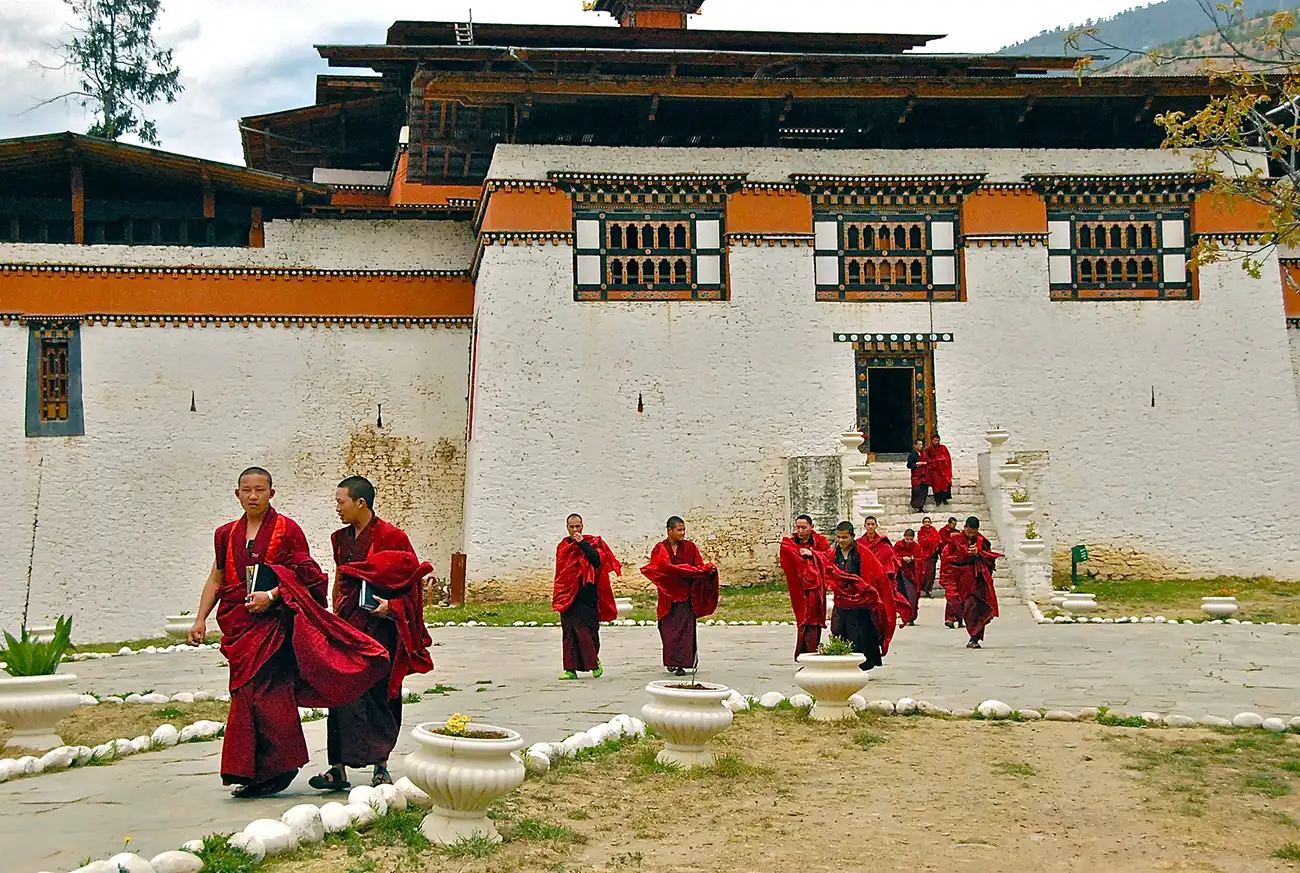
Glimpses into Monastic Life
Visitors to Simtokha Dzong can gain fascinating insights into the daily lives of the resident monks.
- Morning Prayers: Witness the monks’ early morning prayer sessions, where they chant sacred texts and perform rituals in the Dzong’s temples.
- Religious Debates: Occasionally, you can observe lively religious debates among the monks, a traditional practice that fosters intellectual growth and spiritual understanding.
- Community Interactions: Depending on their schedule, some monks might be willing to chat with visitors and offer insights into Buddhism and Bhutanese culture.
Your Journey Through Time and Spirituality
Visiting Simtokha Dzong is a multi-sensory experience that transports you to the heart of Bhutanese culture and spirituality.
Guided Tours: Unveiling the Stories
- Local Expertise: Enrich your visit with a knowledgeable local guide. Guided tours unravel the Dzong’s captivating tales and hidden details, offering a deeper appreciation of its history, architectural nuances, and profound spiritual significance.
- Insider Access: Guided tours often grant access to areas closed to the general public, such as the Dzong’s library, where ancient Buddhist texts reside.
- Cultural Context: Learn about the traditions, rituals, and daily life within the Dzong, gaining a deeper understanding of Bhutanese Buddhism and its role in shaping the nation’s identity.
Scenic Views: A Feast for the Eyes
- Panoramic Vistas: Sangak Zabdhon Phodrang’s elevated position rewards you with breathtaking panoramic views of the Thimphu Valley. Lush green landscapes, traditional Bhutanese houses, and the meandering Thimphu River create a picturesque scene.
- Tranquil Courtyards: The Dzong’s serene courtyards, adorned with prayer wheels and colorful prayer flags, offer peaceful spots to soak in the scenery and capture memorable photos.
- Sunset Magic: Consider timing your visit to coincide with sunset. The golden light bathes the Dzong in a warm glow, creating a magical atmosphere.
Unique Experiences: Engaging with Spirituality
- Prayer Ceremonies: Witness the monks’ daily prayer rituals, a mesmerizing display of chanting and devotion. These ceremonies offer a glimpse into the heart of Bhutanese Buddhist practice.
- Meditation Sessions: If you’re seeking tranquility, inquire about the possibility of participating in a guided meditation session within the Dzong’s peaceful confines.
- Cultural Exchange: Talk to the monks and staff, learning about their experiences and perspectives. This cultural exchange can be a highlight of your visit.
Visitor Testimonials
- “Visiting Simtokha Dzong was a highlight of my trip to Bhutan. The architecture is stunning, and the spiritual atmosphere is palpable. Our guide brought the Dzong’s history to life with fascinating stories and insights.” – Sarah, a traveler from the United States.
- “The views from Sangak Zabdhon Phodrang are simply breathtaking. It’s a peaceful and inspiring place to connect with Bhutanese culture and spirituality.” – Tenzin, a visitor from India.

Finding Your Way: A Guide to Reaching Simtokha Dzong
Simtokha Dzong, a captivating landmark in Bhutan, beckons travelers seeking a taste of history and culture. But you must know how to get there before marveling at its architectural grandeur. This guide provides clear directions and helpful tips to ensure a smooth tour to Simtokha Dzong.
A Short Distance from Bhutan’s Capital
Simtokha Dzong rests just 5 kilometers south of Bhutan’s capital, Thimphu. This proximity makes it a perfect day trip destination or a captivating stop on your Bhutan itinerary.
Reaching the Dzong
Several transportation options are available to reach Sangak Zabdhon Phodrang from Thimphu:
- Taxi: Taxis, abundant in Thimphu, provide a convenient and comfortable mode of transport to Sangak Zabdhon Phodrang. The trip typically takes 15-20 minutes, varying with traffic conditions.
- Bus: Public buses connect Thimphu to various locations, including the area near Sangak Zabdhon Phodrang. While a budget-friendly option, buses may not have a direct stop at the Dzong, and a short walk might be required.
- Car Rental: For those seeking greater flexibility, renting a car in Thimphu allows you to explore Sangak Zabdhon Phodrang at your own pace. While parking near Sangak Zabdhon Phodrang might be limited, its location just 5 kilometers south of Thimphu makes it easily accessible.
Exploring Beyond the Dzong
Beyond the captivating Sangak Zabdhon Phodrang, the surrounding area entices visitors with a treasure trove of additional attractions:
- Folk Heritage Museum: Artifacts and exhibits showcase Bhutanese culture and traditions.
- Takin Preserve: Spot the national animal of Bhutan, the takin, a unique mammal resembling a mix between a cow and a goat.
- Buddha Dordenma: A giant Buddha statue overlooking Thimphu Valley offers panoramic views and a serene atmosphere.

Planning Your Visit
- Opening hours: Visitors are welcome to explore Simtokha Dzong between 9:00 AM and 5:00 PM, though confirming these hours beforehand is recommended for a smooth visit.
- Entry fees: A small entry fee applies to foreign visitors.
Beyond Simtokha Dzong: Unveiling Thimphu’s Hidden Gems
Your Thimphu adventure continues beyond Simtokha Dzong. The capital city captivates with a blend of cultural, historical, and natural wonders, inviting exploration.
Nearby Attractions Worth Your Time
- Tashichho Dzong (Thimphu Dzong): This majestic fortress houses Bhutan’s government and is the summer residence of the monastic body. Marvel at its intricate woodwork, stroll through its serene courtyards and witness the captivating changing of the guard ceremony.
- National Memorial Chorten: This iconic white stupa, adorned with golden spires, stands as a revered landmark and a pilgrimage site for locals. Observe the vibrant spiritual activity as devotees circumambulate the chorten and spin prayer wheels, creating an atmosphere of devotion and tranquility.
- Buddha Dordenma: Perched atop a hill, this colossal bronze statue of Buddha Shakyamuni gazes serenely over Thimphu Valley, offering breathtaking panoramic views. Venture inside to discover 125,000 smaller Buddha statues, adding to the site’s spiritual significance.
- Folk Heritage Museum: Step back in time at this charming museum, where you’ll discover the essence of traditional Bhutanese rural life. Explore authentic farmhouses, witness demonstrations of ancient crafts, and relish a taste of local cuisine at the museum’s inviting restaurant.
- Textile Museum: Delve into the vibrant world of Bhutanese textiles, celebrated for their intricate patterns and rich colors. Learn about the artistry behind traditional weaving techniques and admire the exquisite textiles on display.
Craft Your Perfect Thimphu Itinerary
One-Day Thimphu Highlights
- Morning: Start your day with a visit to Simtokha Dzong, where you can explore its historical and spiritual significance.
- Afternoon: Experience the grandeur of Tashichho Dzong and pay your respects at the National Memorial Chorten.
- Evening: Wander through the city center, browse local shops, and savor a delicious Bhutanese dinner.
Two-Day Thimphu Immersion
- Day 1: Follow the one-day itinerary.
- Day 2: Ascend to the Buddha Dordenma statue for breathtaking views, delve into the Folk Heritage Museum and Textile Museum, and, if your visit coincides with the weekend, experience the lively atmosphere of the weekend market.
Three-Day Thimphu and Beyond
- Day 1 & 2: Enjoy the two-day itinerary.
- Day 3: Venture beyond Thimphu on a day trip to the enchanting Punakha Valley, home to the magnificent Punakha Dzong, which sits majestically at the confluence of two rivers.
Insider Tips for Your Thimphu Adventure
- Traffic: Plan for potential delays in Thimphu, especially during peak hours.
- Dress Code: When visiting dzongs and temples, dress modestly, covering your shoulders and knees.
- Culinary Delights: Savor the flavors of Bhutanese cuisine, known for its signature dishes like ema datshi (chili and cheese) and momos (dumplings).
Your Bhutanese Adventure Awaits
Simtokha Dzong isn’t just a historical landmark; it’s a living testament to Bhutan’s rich cultural heritage and spiritual devotion. From its strategic hilltop perch overlooking Thimphu Valley to its intricate architecture and vibrant religious life, the Dzong offers a captivating glimpse into the heart of Bhutanese identity.
Key Takeaways
- A Living Legacy: Sangak Zabdhon Phodrang is one of Bhutan’s oldest and most significant fortresses, founded by the visionary Zhabdrung Ngawang Namgyal in 1629.
- Architectural Marvel: Explore the Dzong’s unique blend of defensive structures and sacred spaces adorned with intricate woodwork, colorful murals, and revered statues.
- Spiritual Center: Witness the daily rituals of the resident monks, delve into Buddhist philosophy, and perhaps even participate in a meditation session.
- Cultural Immersion: Engage with local guides, learn about Bhutanese traditions, and capture stunning views of the surrounding landscape.
Discover Simtokha Dzong for Yourself
A visit to Simtokha Dzong is an invitation to step back in time and connect with the essence of Bhutanese culture. Whether you’re a history buff, a spiritual seeker, or a curious traveler, this ancient fortress promises a unique and unforgettable experience.
Plan your visit to Simtokha Dzong today and let its stories, artistry, and spirituality weave their magic on you. Bhutan’s “Palace of the Profound Meaning of Secret Mantras” awaits your discovery.
